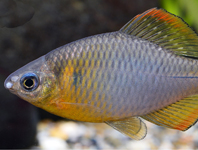Abstract
For the first time a subgeneric classification of the oil-collecting bee genus Rediviva is presented. Five subgenera comprising 33 species are recognized based on morphological characters. Three of them are described as new: Deriviva subgen. nov., Albiviva subgen. nov. and Gigaviva subgen. nov.. The genus Redivivoides rendered Rediviva paraphyletic and is downgraded to subgenus level. A key is provided to enable the identification of subgenera.
References
Cockerell, T.D.A. (1931) Some African bees. Annals and Magazine of Natural History, Series 10, 8, 400–410.
https://doi.org/10.1080/00222933108673410
Cockerell, T.D.A. (1933) Descriptions and records of bees—CXLV. Annals and Magazine of Natural History, Seris 10, 12, 126–136.
https://doi.org/10.1080/00222933308673758
Dellicour, S., Lecocq, T., Kuhlmann, M., Mardulyn, P. & Michez, D. (2014) Molecular phylogeny, biogeography, and host plant shifts in the bee genus Melitta (Hymenoptera: Anthophila). Molecular Phylogenetics and Evolution, 70, 412–419.
https://doi.org/10.1016/j.ympev.2013.08.013
Friese, H. (1911) Neue Bienen der äthiopischen Region. Zoologische Jahrbücher, Abteilung für Systematik, Geographie und Biologie der Tiere, 30, 671–678.
Kahnt, B., Hattingh, W.N., Theodorou, P., Wieseke, N., Kuhlmann, M., Glennon, K.L., van der Niet, T., Paxton, R. & Cron, G.V. (2019) Should I stay or should I go? Pollinator shifts rather than cospeciation dominate the evolutionary history of South African Rediviva bees and their Diascia host plants. Molecular Ecology, 28, 4118–4133.
https://doi.org/10.1111/mec.15154
Kahnt, B., Montgomery, G.A., Murray, E., Kuhlmann, M., Pauw, A., Michez, D., Paxton, R.J. & Danforth, B.N. (2017) Playing with extremes: Origins and evolution of exaggerated female forelegs in South African Rediviva bees. Molecular Phylogenetics and Evolution, 115, 95–105.
https://doi.org/10.1016/j.ympev.2017.07.025
Kahnt, B., Theodorou, P., Soro, A., Hollens-Kuhr, H., Kuhlmann, M., Pauw, A. & Paxton, R.J. (2018) Small and genetically highly structured populations in a long-legged bee, Rediviva longimanus, as inferred by pooled RAD-seq. BMC Evolutionary Biology, 18 (196), 1–12.
https://doi.org/10.1186/s12862-018-1313-z
Kuhlmann, M. (2009) Patterns of diversity, endemism and distribution of bees (Insecta: Hymenoptera: Anthophila) in southern Africa. South African Journal of Botany, 75, 726–738.
https://doi.org/10.1016/j.sajb.2009.06.016
Kuhlmann, M. (2012a) Two new species of the South African endemic bee genus Rediviva Friese (Hymenoptera: Apoidea: Melittidae). Zootaxa, 3517 (1), 71–78.
https://doi.org/10.11646/zootaxa.3517.1.4
Kuhlmann, M. (2012b) Revision of the South African endemic bee genus Redivivoides Michener, 1981 (Hymenoptera: Apoidea: Melittidae). European Journal of Taxonomy, 34, 1–34.
https://doi.org/10.5852/ejt.2012.34
Kuhlmann, M. (2015) Nest architecture and use of floral oil in the oil-collecting South African solitary bee Rediviva intermixta (Cockerell) (Hymenoptera: Apoidea: Melittidae). Journal of Natural History, 48, 2633–2644.
https://doi.org/10.1080/00222933.2014.909069
Kuhlmann, M. & Hollens, H. (2015) Morphology of oil-collecting pilosity of female Rediviva bees (Hymenoptera: Apoidea: Melittidae) reflects host plant use. Journal of Natural History, 49, 561–573.
https://doi.org/10.1080/00222933.2014.939732
Manning, J.C. & Goldblatt, P. (2002) The pollination of Tritoniopsis parviflora (Iridaceae) by the oil-collecting bee Rediviva gigas (Hymenoptera: Melittidae): the first record of oil-secretion in African Iridaceae. South African Journal of Botany, 68, 171–176.
https://doi.org/10.1016/S0254-6299(15)30416-6
Manning, J.C. & Goldblatt, P. (2005) Radiation of pollination systems in the Cape genus Tritoniopsis (Iridaceae: Crocoidae) and the development of bimodal pollination strategies. International Journal of Plant Science, 166, 459–474.
https://doi.org/10.1086/428703
Michener, C.D. (1981) Classification of the bee family Melittidae with a review of species of Meganomiinae. Contributions of the American Entomological Institute, 18, 1–135.
Michener, C.D. (2007) The Bees of the World. 2nd Edition. Johns Hopkins University Press, Baltimore, Maryland, 992 pp.
Michez, D., Terzo, M. & Rasmont, P. (2004) Phylogénie, biogéographie et choix floraux des abeilles oligolectiques du genre Dasypoda Latreille 1802 (Hymenoptera, Apoidea, Melitidae). Annales de la Société entomologique de France, New Series, 40 (3–4), 421–435.
https://doi.org/10.1080/00379271.2004.10697431
Michez, D., Patiny, S. & Danforth, B.N. (2009) Phylogeny of the bee family Melittidae (Hymenoptera: Anthophila) based on combined molecular and morphological data. Systematic Entomology, 34, 574–597.
https://doi.org/10.1111/j.1365-3113.2009.00479.x
Pauw, A., Kahnt, B., Kuhlmann, M., Michez, D., Montgomery, G.A., Murray, E. & Danforth, B.N. (2017) Long-legged bees make adaptive leaps: linking adaptation to coevolution in a plant–pollinator network. Proceedings of the Royal Society B, 284 (20171707), 1–7.
https://doi.org/10.1098/rspb.2017.1707
Steiner, K.E. & Whitehead, V.B. (1990) Pollinator adaptation to oil-secreting flowers - Rediviva and Diascia. Evolution, 44, 1701–1707.
https://doi.org/10.1111/j.1558-5646.1990.tb03857.x
Steiner, K.E. & Whitehead, V.B. (1991) Oil flowers and oil bees: further evidence for pollinator adaptation. Evolution, 45, 1493–1501.
https://doi.org/10.1111/j.1558-5646.1991.tb02651.x
Steiner, K.E. & Whitehead, V.B. (1996) The consequences of specialization for pollination in a rare South African shrub, Ixianthes retzioides (Scrophulariaceae). Plant Systematics and Evolution, 201, 131–138.
https://doi.org/10.1007/BF00989056
Steiner, K.E. & Whitehead, V.B. (2002) Oil secretion and the pollination of Colpias mollis (Scrophulariaceae). Plant Systematics and Evolution, 235, 53–66.
https://doi.org/10.1007/s00606-002-0216-y
Vences, M., Guayasmin, J.M., Miralles, A. & de la Riva, I. (2013) To name or not to name: Criteria to promote economy of change in Linnaean classification schemes. Zootaxa, 3636 (2), 201–244.
https://doi.org/10.11646/zootaxa.3636.2.1
Whitehead, V.B. & Steiner, K.E. (1993) A new Rediviva bee (Hymenoptera: Apoidea: Melittidae) that collects oil from orchids. African Entomology, 1, 159–166.
Whitehead, V.B. & Steiner, K.E. (2001) Oil-collecting bees of the winter rainfall area of South Africa (Melittidae, Rediviva). Annals of the South African Museum, 108, 143–277.
Whitehead, V.B., Steiner, K.E. & Eardley, C.D. (2008) Oil-collecting bees mostly of the summer rainfall area of southern Africa (Hymenoptera: Melittidae: Rediviva). Journal of the Kansas Entomological Society, 81, 122–141.
https://doi.org/10.2317/JKES-703.12.1


